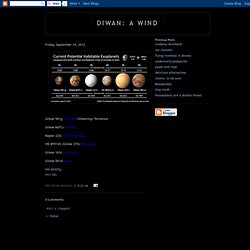

Naming exoplanets, redux. Barnard's star (for real) (via darksands dot com) So Barnard's Star does have a planet after all!

Behind that paywall, i would know more than its period (233 days) & mass (3.2 times Earth's), but using Hipparchos' visual magnitude 9.54 & parallax 0".54901, & 0.144 times solar mass (i had always thought around 0.15) & other info like stellar temperature (M4) 3134 K from Wikipedia...i get a visual luminosity of 1/4126 & (BC -2.10 [they seem to be using a bit higher]) bolometric of 1/596. Which makes this planet orbit just at 36.1 million miles (albeit varying 11.55 either way-- this orbit is eccentric), for a blackbody temperature of a little less than 91 K.
That's cold. Ammonia would be frozen, even. What kind of world is this, rocky, gaseous, or some unheard-of middle thing? Not sure if the eccentricity means methane would be sometimes liquid, sometimes frozen & sometimes gaseous, but that's not a ridiculous scenario. "Vulcan" found where it should be (sort of) (theseastorm via) Writers who use an extensive vocabulary (Ryling, A Theroux, Pynchon) are like microtonal composers; they just need more notes.

Rumi & "The Guests. " The Vulcan discovery paper finds an 8.47 earth-mass planet in a 42.378 day orbit around the star HD 26965 (omicron-2 Eridani A, HIP 19849, "Keid," HR 1325 & Gliese 166A), which is a triple with a white dwarf-red dwarf pair at 82" (some 418 AU), making one revolution in some 8000 years. The age of the system is given as 6.9 billion years--though the white dwarf may only be 122 million years old & must have been some kind of red giant before that (& then a "planetary nebula"--thought to be toxic for any nearby planetary life). Hipparchos gives the parallax as 0".1985657 & the visual magnitude of the K0 V primary as 4.43. Some more general reflections...
Proxima b. (via space dot com) So Proxima has a planet...
Proxima-alpha orbit update --"...it takes 590,000 years to make a single orbit." – graywyvern
Also known as Gliese 551 & HIP 70890, this dim red flare star (according to the paper, visual magnitude 11.05 at 1.295 parsecs--for a parallax of "0.7722, although Hipparcos gives 0.77233--), which is probably (but not certainly?)

Coeval with Alpha Centauri, with spectral type M5.5 V (3054 K), stellar mass 0.118 ⊙ (2/17) and observed radius 0.1410 (or 1/7th ⊙), appears to have a planet of at least 1.27 (about 52/41) ⊕ in a close, 11.186 (1/33 y.) National Geographic - Alien Worlds (Part 1) Planetnames.
Now that Ravanastron is no more, i am starting to call Proxima b "Hercolubus": – graywyvern
Habitable exoplanets. Diwan: A Wind Friday, September 14, 2012.
11/18 the current list (55) starts with proxima b, kapteyn b, & gj667 Cc now – graywyvern
4/17 the conservative list is twelve; the optimistic list, 39... – graywyvern
Note that with prox b, the total now is ten (9/16): – graywyvern

Exoplanets in Terms of Distance. Exoplanets in order of Distance [Cf] 1. ε (epsilon) Eridani b.
HR 8832b: (3/17) (oh, i see, it's #11 now) – graywyvern
Of course, there is now the planet at alpha Centauri: Albertus Alauda. (WELL..there was for a while.) – graywyvern
Constellation: Eidanus (the [Po] River). 10.5 LY; Sp= K2 Mj= 1.55 P,d= 2502 (6.8y).

My name: Sofonisba. Hipparcos. SolStation.com.